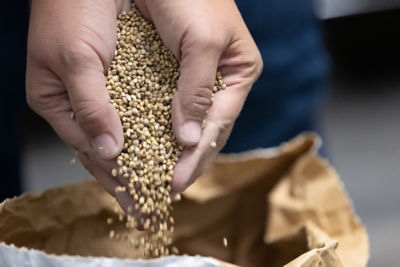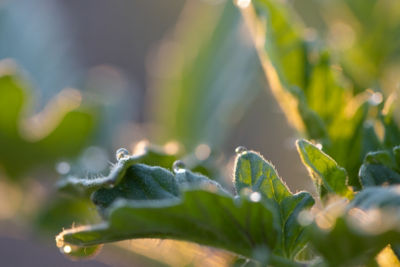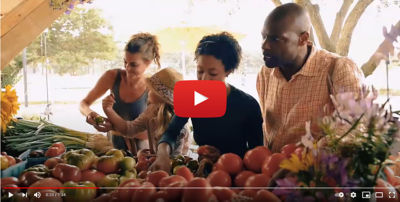Click here to download a PDF version of this Cultivation Insights article.
» Pepper plants benefit from pollination activities in greenhouse production systems.
» Mechanical vibration and insect pollination are used to help increase the number, weight, and size of pepper fruits.
» Using commercially available bumble bees has become a common method of pollination for greenhouse peppers.
Pepper plants (Capsicum annuum) have “perfect” flowers, meaning that the flowers have both female and male reproductive parts (Figure 1). This allows for self-pollination, with the pollen from the anthers falling on the adjacent stigma of the female part of the flower. The flowers need to be shaken to help release the pollen. In open-field production, this shaking is done mostly by wind.1,2,3 However, peppers are not considered to be 100% self-pollinating, and 2 to 90% of fertilization can result from outcrossing (fertilization with pollen from other plants).4
 Figure 1. A “prefect” pepper flower with male and female reproductive parts.
Figure 1. A “prefect” pepper flower with male and female reproductive parts.
In greenhouse production, the amount of airflow is usually not sufficient to help with the self-pollination process, and poor pollination can be a problem, resulting in low yields and reduced fruit quality.1,2 Pollination of greenhouse-grown peppers usually requires the use of mechanical agitation or the use of insect pollinators, such as bees.2,4 Honeybees, solitary bees, and bumble bees can be used to pollinate peppers in greenhouse production, with bumble bees used most commonly by commercial growers (Figure 2).1,2,4
PEPPER POLLINATION BY BEES
Bees are some of the most important pollinators of crop species, even helping to improve fertilization rates for self-pollinating species such as tomatoes and peppers. Pepper flowers produce nectar and are attractive to a range of insect pollinators including honeybees, solitary bees, bumble bee species, and alfalfa leaf cutting bees.1,3 Studies have shown that insect pollination of greenhouse-grown peppers can help increase fruit weight, fruit quality, seeds per fruit, the speed of maturation, and the percentage of large and extra-large fruit when compared to self-pollinated plants.3,5 One study showed that bee-pollinated flowers produced fruit with a seed set of 40 to 50%, while self-pollinated flowers had seed set rates of 26 to 28%. The percentage seed set was strongly related to the number of bee visits to the flower and the number of pollen grains deposited on the flower stigmas.3
 Figure 2. Bumble bee (Bombus impatiens). David Cappaert, Bugwood. org.
Figure 2. Bumble bee (Bombus impatiens). David Cappaert, Bugwood. org.
USING BUMBLE BEES
Bumble bees, mostly Bombus impatiens, are used in greenhouse production systems more commonly than honeybees because their life cycle and colony characteristics are more compatible with greenhouse settings. Bumble bee colonies are usually small, about 300 bees, compared to honeybee colonies, which can be as large as 30,000 bees. Bumble bee colonies can be contained in boxes that are easy to transport and place in greenhouses (Figure 3). In addition, bumble bees are very efficient pollinators and can remain active during periods of cold weather and low light better than honeybees, and bumble bees are less aggressive than honeybees, making them safer for workers to be around.2,6 Short visits to the flower, of approximately 12 seconds, are sufficient, with one to two visits per flower providing the highest level of pollination.5 Bumble bees focus on foraging on the most readily available plants, usually visiting flowers early in the morning when pollen is released (anthesis) and flowers are most receptive to fertilization. The bees prefer flowers that produce the most nectar and have the highest level of stigma receptivity. Bumble bee colonies are short-lived, usually lasting eight to twelve weeks before needing to be replaced.1,2,3,5
GREENHOUSE COVERS AND CRACKING
It has been shown that the materials used to cover greenhouses can affect the intensity and quality of light entering the greenhouse. Glass, plastic films, and rigid plastic panels vary in total light transmission, the selective transmission of different wavelengths of light in the photosynthetically active region (PAR) and near-infrared, and the ability to block UV-A and UV-B wavelengths. The materials can also affect the house’s temperature, humidity, and vapor pressure deficit levels.7,8,9 Some studies have shown that these differences can result in changes in the quality of tomato fruit and potentially affect the level of fruit cracking.7,8,10 Materials that result in higher temperatures and higher humidity levels may increase the likelihood of fruit cracking during the summer months. A house’s airtightness or leakiness can also affect the stability of temperature and humidity conditions, with fluctuating temperatures and high humidity conditions more likely to contribute to increased cracking. The use of shade cloth in greenhouses in the summer in Greece was shown to decrease the levels of fruit cracking by up to 50% compared to nonshaded houses.8
 Figure 3. Commercially produced bumble bee colonies used in the pollination of greenhouse grown crops.
Figure 3. Commercially produced bumble bee colonies used in the pollination of greenhouse grown crops.
FAVORABLE CONDITIONS
One to three colonies are usually sufficient for the pollination of 16,000 ft2 (1,500 m2) of greenhouse-grown peppers.2,3 With too many bees (too few flowers per bee), bumble bees will leave the house to forage outside or repeatedly revisit the same flowers, which can cause damage and lead to blossom drop. So, growers should start with the smallest number of bees needed for the space to prevent over-pollination activity. Early in the flowering stage, it may be necessary to periodically confine the bees to their box until more flowers become available. Bees return to the hive at night; the box entry holes can be closed to prevent the bees from exiting the hives, and sugar water or honey solutions can be provided to keep the bees fed while they are confined.2 Colonies should be placed off the ground in a location facing but “downwind” from the plants. Bees like to take off in the direction of airflow and tend to fly to the plants in front of them.2
Peppers need nighttime temperatures between 55 and 70 °F (13 to 21 °C) for pollen production, and daytime temperatures should not exceed 90 °F (32 °C) for adequate pollination. Temperatures over 90 °F can result in flower abortion and damage developing broods of bees. Hives should be placed in a shaded location within the house to prevent overheating.2,6 Relative humidity levels should be between 50 and 80%. If humidity levels are too low, the pollen will not adhere to the stigma. If levels are too high, the pollen becomes very sticky and does not get released from the anthers.2
Bees use UV light to help keep them oriented in their environment, so using UV-excluding greenhouse covering materials can interfere with the bee’s ability to maintain good orientation. It is preferable to use cover materials, such as glass, ridged acrylic, and polyethylene films that allow the transmission of UV wavelengths. Most rigid polycarbonate materials and polyvinyl chloride (PVC) films block UV light transmission, resulting in bees becoming disoriented in the house. Some polyethylene films may include UV blockers meant to increase the usable life of the material, but this will also be problematic for bees. The absence of UV light may also prevent the breakdown of some pesticides that can be harmful to bees.2,6
Using supplemental lighting in the winter can also be detrimental to the longevity of bumble bee colonies. Sometimes, colonies can recover when sufficient ambient (sun) light becomes available, but colonies may need to be replaced more frequently during the winter months.2
Bees used as pollinators in greenhouses need to be protected from pesticides that can be lethal or harmful to bees. Weakened bees forage less and are less effective at pollinating. Growers should try to avoid the application of pesticides that are harmful to bees during the pollination period. If possible, apply pesticides through the irrigation system rather than with foliar sprays to limit bee exposure. The use of less harmful products is preferred, and if applications are needed, they should be made at night when the bees are less active and most likely to be inside the hive. Hive entrances can be closed at night to keep bees inside during application periods.2,6
SOURCES
1Azmi, W., Seng, C., and Solihin, N. 2016. Pollination efficiency of the stingless bee, Heterotrigona itama (Hymenoptera: Apidae) on chili (Capsicum annuum) in greenhouse. Journal of Tropical Plant Physiology 8:1-11.
2Phillips, B. 2019. Bumble bees in greenhouse vegetable production. Michigan State University Extension. https://www.canr.msu.edu/news/bumble-bees-in-greenhouse-vegetable-production.
3Roldán Serrano, A. and Guerra-Sanz, J. M. 2006. Quality fruit improvement in sweet pepper culture by bumblebee pollination. Scientia Horticulturae 110:160-166. https://doi.org/10.1016/j.scienta.2006.06.024.
4Bosland, P. and Votava, E. 2012. Peppers: vegetable and spice capsicums, 2nd Edition. CABI. Ppg 55-56.
5Riaño J., Pacateque E., Cure, J., Rodríguez, D. 2015. Pollination behavior and efficiency of Bombus atratus Franklin in sweet peppers (Capsicum annum L.) grown in a greenhouse. Revista Colombiana de Ciencias Hortícolas 9(2):259-267.
6Evans, E. 2010. Bumble bees. In Mader, E., Spivak, M., and Evans, E. (eds.) Managing alternative pollinators: a handbook for beekeepers, growers, and conservationists, SARE Handbook 11, NRAES-186.
Websites verified 3/3/2025
ADDITIONAL INFORMATION
Performance may vary, from location to location and from year to year, as local growing, soil and weather conditions may vary. Growers should evaluate data from multiple locations and years whenever possible and should consider the impacts of these conditions on their growing environment. The recommendations in this article are based upon information obtained from the cited sources and should be used as a quick reference for information about greenhouse cucumber production. The content of this article should not be substituted for the professional opinion of a producer, grower, agronomist, pathologist and similar professional dealing with this specific crop.
BAYER GROUP DOES NOT WARRANT THE ACCURACY OF ANY INFORMATION OR TECHNICAL ADVICE PROVIDED HEREIN AND DISCLAIMS ALL LIABILITY FOR ANY CLAIM INVOLVING SUCH INFORMATION OR ADVICE.
6414_520400 Published 03-03-2025



